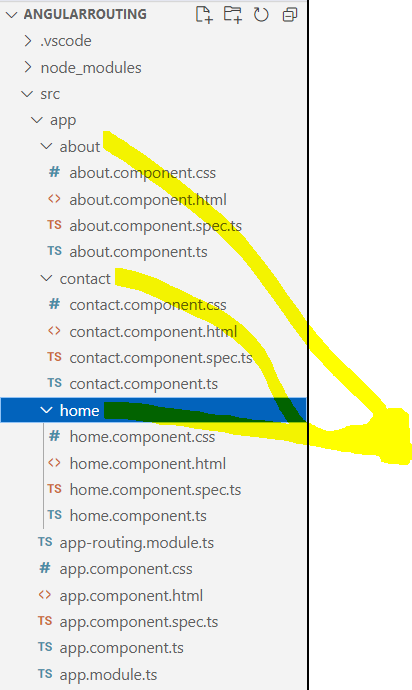Angular Wildcard and Redirect Routing
What is Routing?
A website or application have many pages. When we redirect one page to another page. So it is called routing in application. Navigation makes it easy for users to find what they are looking for in web applications or website. Angular support single page application development so one page is devided in multiple sections. Every section defines a unit of code or specific task which is called component in angular. So when we navigate from one section to another section or component. It can be simply achieved by implementing routing in angular.
Create an application
The following command uses the Angular CLI to create a Angular application. The application name in the following example is Angular Routing.
ng new AngularRouting
Adding components for routing
The following command uses the Angular CLI to create component. The components name in the following example is home, about, contact.
ng generate component homeng generate component about
ng generate component contact
After creating our components, we will have three components in
separate folders shown in below image.
Now we will open about.component.html from the about folder and add the following code to show on browser lator.
Now we will open home.component.html from the home folder and add the following code to show on browser lator.
Now we will open contact.component.html from the contact folder and add the following code to show on browser lator.
Importing your new components
We open app-routing.module.ts which looks like below:
import { NgModule } from '@angular/core';
import { RouterModule, Routes } from '@angular/router';
const routes: Routes = [];
@NgModule({
imports: [RouterModule.forRoot(routes)],
exports: [RouterModule]
})
export class AppRoutingModule { }Import RouterModule and Routes into your routing module. To use created components, importing them into app-routing.module.ts at the top of the file as follows:
import { HomeComponent} from './home/home.component';
import { ContactComponent } from './contact/contact.component';
import { AboutComponent } from './about/about.component';Now define your routes in your Routes array.
const routes: Routes = [
{ path: 'about', component: AboutComponent },
{ path: 'home', component: HomeComponent},
{ path: 'contact', component: ContactComponent },
];After importing and define route array. app-routing.module.ts file looks like below:
import { NgModule } from '@angular/core';
import { RouterModule, Routes } from '@angular/router';
import { HomeComponent } from './home/home.component';
import { ContactComponent } from './contact/contact.component';
import { AboutComponent } from './about/about.component';
const routes: Routes = [
{ path: 'about', component: AboutComponent },
{ path: 'home', component: HomeComponent},
{ path: 'contact', component: ContactComponent },
];
@NgModule({
imports: [RouterModule.forRoot(routes)],
exports: [RouterModule]
})
export class AppRoutingModule { }
<router-outlet> - This element informs Angular to
change the application view with the
components for the selected route which you defined.
Routes
-Define your routes in your Routes array.
We add the following code to the app.component.html
<nav>
<a routerLink="/home">Home</a>
<a routerLink="/about">About</a>
<a routerLink="/contact">Contact</a>
<div class="animation start-home"></div>
</nav>
<router-outlet> </router-outlet>Add the css code to design menu in app.component.css
nav {
position: relative;
width: 590px;
height: 50px;
background-color: #34495e;
border-radius: 8px;
font-size: 0;
}
nav a {
line-height: 50px;
height: 100%;
font-size: 15px;
display: inline-block;
position: relative;
z-index: 1;
text-decoration: none;
text-transform: uppercase;
text-align: center;
color: white;
cursor: pointer;
}
nav .animation {
position: absolute;
height: 100%;
top: 0;
z-index: 0;
transition: all .5s ease 0s;
border-radius: 8px;
}
a:nth-child(1) {
width: 100px;
}
a:nth-child(2) {
width: 110px;
}
a:nth-child(3) {
width: 100px;
}
a:nth-child(4) {
width: 160px;
}
a:nth-child(5) {
width: 120px;
}
nav .start-home, a:nth-child(1):hover~.animation {
width: 100px;
left: 0;
background-color: #1abc9c;
}
nav .start-about, a:nth-child(2):hover~.animation {
width: 110px;
left: 100px;
background-color: #e74c3c;
}
nav .start-blog, a:nth-child(3):hover~.animation {
width: 100px;
left: 210px;
background-color: #3498db;
}
nav .start-portefolio, a:nth-child(4):hover~.animation {
width: 160px;
left: 310px;
background-color: #9b59b6;
}
nav .start-contact, a:nth-child(5):hover~.animation {
width: 120px;
left: 470px;
background-color: #e67e22;
}
body {
font-size: 12px;
font-family: sans-serif;
background: #2c3e50;
}
h1 {
text-align: center;
margin: 40px 0 40px;
text-align: center;
font-size: 30px;
color: #ecf0f1;
text-shadow: 2px 2px 4px #000000;
font-family: 'Cherry Swash', cursive;
}
p {
position: absolute;
bottom: 20px;
width: 100%;
text-align: center;
color: #ecf0f1;
font-family: 'Cherry Swash',cursive;
font-size: 16px;
}
span {
color: #2BD6B4;
}Now run the application. Open with the following URL: http://localhost:4200/
Redirect Routing
Redirect routing is also the part of routing. when we open any application o run by default it will navigate to the following URL -http://localhost:4200/ . It will not redirect any page without define default routing any page. So we need to define it with redirectTo property in angular.
Now we want to view by default home page when application run. adding redirectTo property to app-routing.module.ts.
const routes: Routes = [
{ path: 'home', component: HomeComponent},
{ path: 'about', component: AboutComponent },
{ path: 'contact', component: ContactComponent },
{ path: '', redirectTo: '/home', pathMatch: 'full' }, //RedirectTo Routing
];Now run the application by defaut it will count home page.

Wildcard Routing
when we try to attempt to navigate to a part of your application that does not exist in the component or section. To add this functionality in your application, you need set up a wildcard route. It is defined with ** sign.
Adding wildcard route to on app-routing.module.ts file
const routes: Routes = [
{ path: 'home', component: HomeComponent},
{ path: 'about', component: AboutComponent },
{ path: 'contact', component: ContactComponent },
{ path: '', redirectTo: '/home', pathMatch: 'full' },
{ path: '**', component:NotfoundComponent }, //Wildcard Routing
];As shown above we have added one component named Notfound. using following CLI command:
ng g c Notfound
Now run the application and enter url navigation name which is not existes.

Prev Next

